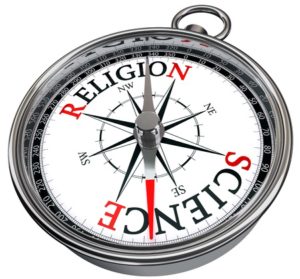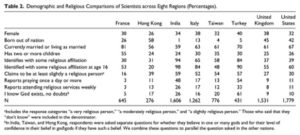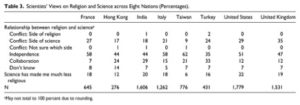“Conflict” Between Science and Religion

The watershed event for the perceived conflict between science and religion in American culture was the Scopes Trial. After William Jennings Bryan’s speech opposing the admission of expert testimony on evolution in the trial, the lead defense lawyer, Dudley Malone, said he defied anyone “to believe that this is not a religious question.” Malone went on to say: “We feel we stand with science. We feel we stand with intelligence.” In his closing remarks, the chief prosecutor, Tom Stewart said: “They say it is a battle between religion and science. If it is, I want to serve notice now, in the name of the great God, that I am on the side of religion.” So the premise there was conflict between science and religion was present within the Scopes Trial from the very beginning.
That battle continues today, notably by individuals like the biologist Richard Dawkins, who said: “I am very hostile to religion because it is enormously dominant, especially in American life. And I don’t buy the argument that it’s harmless.” But is this conflict model the way scientists today see science and religion? Recently, Elaine Howard Ecklund and a team of researchers completed a survey of over 22,500 scientists from around the world. They investigated the scientists’ perceptions of the interface of science and religion, as well as the personal religiosity of the scientists. Their study, “Religion Among Scientists in International Context,” can be found here.
Ecklund et al. acknowledged that globally, science and religion have an “uncertain” relationship. Richard Dawkins sees conflict; but Francis Collins, the Director of the National Institute of Health (NIH), sees compatibility. And the debates resulting from this uncertain relationship have been occurring outside the U.S. For example, there was an uproar among faculty at the University of Hong Kong when Hong Kong’s Education Bureau proposed guidelines to teach intelligent design in the public school system. Debates about science and religion are taking place around the globe and scientists are taking part in the discussions.
Do scientists from national contexts with very different approaches to religion still think the rationalism and supposed secularity of science will overtake the truth claims of religion? Or are they—especially when it comes to matters of personal religious identity—more similar to those in their local national contexts? Is a global science taking over the world of religion? Or are there even ways that religious communities and scientific communities can work together for the common good around the globe?
The Religion Among Scientists in International Context (RASIC) study assessed biologists and physicists from eight regional areas—France, Hong Kong, India, Italy, Taiwan, Turkey, the UK and the US. RASIC looked at how scientists understood religion, how their religiosity compared to that of their local population, and the implications of their findings for different views on the connection between science and secularity.
In four of the regions, Italy, India, Turkey and Taiwan, over 50% of scientists had a religious affiliation. The highest percentage was in India, where 94% of scientists reported religious affiliations of some sort. The three regions with the lowest reported religious affiliations were France (16%), the United Kingdom (27%) and the United States (30%). In all regions except Hong Kong and Taiwan, a higher proportion of scientists indentified with a religion when they were 16 than they do now. Belief in God among scientists ranged widely from Turkey with the highest (61%) to France with the lowest (5%). The UK and the US, which are at the heart of the global scientific infrastructure, reported proportions consistent with earlier surveys of belief among so-called elite scientists.
Ecklund et al. said that from their data on religious beliefs, practices or identities, it was difficult to conclude that science and religion were in conflict. See “Scientist, What do You Believe?” for more information on the earlier surveys. Also see the table below, taken from the Ecklund et al. report of the RASIC study.
However, when scientists are compared to their local religious populations, there was evidence of lower religiosity among scientists. In France, the UK and the US, the proportion of the general population who attends religious services once a week or more were at least two time larger than the scientists from the same region. The gap was widest in the US, where 33% of the population reported at least weekly attendance, compared to 11% of scientists. “The majority of scientists in the US (60 percent), UK (66 percent), and France (81 percent) are nonattenders.” The proportion of scientists who have a religious identification was lower than the general population in every region but Hong Kong and Taiwan. See Figures 1 and 2 in the Ecklund et al. report for more information on these issues.
The views of scientists on the science-faith interface were counter-intuitive if you believed the conflict narrative. “A substantial majority of physicists and biologists in the eight regional contexts studied do not adhere to this view.” The conflict narrative would also presume most scientists would see the science-religion relationship as one of conflict, and then take the side of science. But only in the UK and the US did those percentages approach or exceed 30%.
The prevailing view among scientists is that science and religion are independent of one another. France, Italy, Taiwan and the US had 50% or more of their scientists seeing religion and science as independent of one another, while all other regions had at least 35%. Ecklund et al suggested that Stephen Jay Gould’s concept of science and religion as “nonoverlapping magisterial” was helpful here. The concept refers to science and religion as nonoverlapping spheres, with science dealing with the empirical observation of the natural world and religion dealing with meaning.
Another surprising finding for the conflict view was with how scientists thought their exposure to science influenced their views on religion. No more than 22% of scientists in the US thought their exposure to science made them less religious; and the US was the region with the highest percentage. See Table 3 taken from the Ecklund et al. report of the RASIC study for more information on these topics.
In her review of the study for BioLogos, Sarah Lane Ritchie gleaned “five surprising facts” from the study, repeating several of those noted above. Significantly for evangelical Christians, she thought the study went a long way in dispelling the myth that scientists themselves are hostile towards religion or not at all religious. When the public discourse surrounding science and religion consistently depicts “evolution-affirming scientists as being at war with evolution-denying religious individuals or groups … it is easy for public perception to become skewed in a way that does not reflect the facts.”
She concluded that not only were many scientists religious, but even those who were not religious generally held an independence view, rather than a conflict view, of how science and religion were related. “This research undermines both the conflict narrative surrounding science and religion, and the assumption that scientists themselves are not religious.” So the conflict model of the relationship between science and religion is not the dominant view of most scientists, but it seems to be deeply influential at the popular level, especially among evangelical Christians in the US. To a certain extent, this influence dates back to the Scopes Trial.
Alister McGrath, who holds advanced degrees in both science and theology, remarked in Science and Religion how the Scopes Trial was a public relations disaster for conservative, fundamentalist Christians. He noted how William Jennings Bryan had unwisely framed the trial as a “duel to the death” between Christianity and atheism. Clarence Darrow, a well-known attorney—and agnostic—on the Scopes defense team, was able discredit Bryan by simply calling him as a witness for the defense.
The legal move was as simple as it was brilliant: Bryan was called to the stand as a witness for the defense, and interrogated concerning his views on evolution. Bryan was forced to admit that he had no knowledge of geology, comparative religions or ancient civilizations, and showed himself to have hopelessly naïve religious views. The “monkey trial” (as it is widely known) came to be seen as a symbol of reactionary religious thinking in the face of scientific progress.
Several scholars consider the Scopes Trial to be a key event in the restructuring of American religion. One of those, Edward Larson, said it would be difficult to overestimate the importance of the Scopes Trial had in transforming Christian fundamentalism in the U.S. Afterwards elite American society stopped taking it seriously. The trial’s setting stamped the entire movement with an irrevocable image of the rural, small town South. The national media stopped covering its normal activities. Conservative Christians rapidly lost power within the mainline denominations. And most significantly, a string of defeats occurred for antievolution legislation in the northern states. While fundamentalists responded by withdrawing from political and cultural encounters for several decades, the Scopes Trial came to embody the “conflict” between science and religion.
The quotes in the introductory paragraph were taken from Edward Larson’s Pulitzer Prize winning book on the Scopes Trial, Summer for the Gods.


